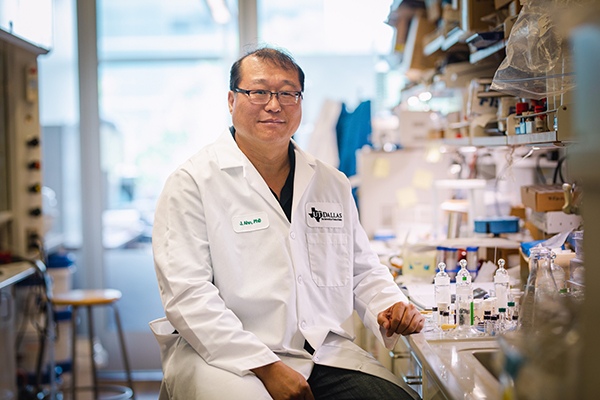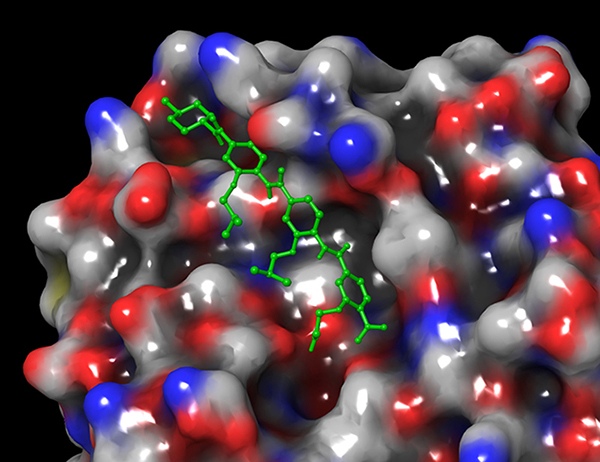
ERX-41, A New Paradigm for Cancer Treatment by Dr. Jung-Mo Ahn
Cancer treatment by targeting lysosomal acid lipase A (LIPA) protein with a newly synthesized compound, ERX-41, provides promise for some of the hard-to-cure cancers. A research team led by Dr. Jung-Mo Ahn at the University of Texas at Dallas recently published their findings in Nature Cancer.
Dr. Jung-Mo Ahn, an expert in synthesizing small molecule inhibitors for protein-protein interaction by adopting a rational structure-based design approach, recently designed a new compound, ERX-41, which not only kills estrogen receptor (ER)-positive breast cancer but also effectively shrinks human cancers. This capability is especially promising in treating triple-negative breast cancer (TNBC) – a cancer subtype lacking receptors for estrogen. During his research, Dr. Ahn discovered that ERX-41 is capable of inhibiting the lysosomal acid lipase A (LIPA) protein, which resides in the endoplasmic reticulum, an organelle that processes and folds proteins. Cancer cells significantly overproduce LIPA, much more than healthy cells. By binding to LIPA, ERX-41 blocks protein processing in the endoplasmic reticulum which in turn leads to cancer cell death.
ERX-41 presents a new paradigm in cancer treatment, paving the way for many possibilities in the future.
We are very honored to be able to interview Dr. Ahn about his research methods and coming available drugs stemming from his research.

Q: Congratulations on your groundbreaking research in synthesizing a molecule called ERX-41 that can combat a variety of difficult-to-treat cancers. First of all, please tell us about both your education and research background that led up to this achievement.
A: I am a bio-organic/medicinal chemist and received my bachelor, master, and doctoral degrees at the Seoul National University in Seoul, South Korea (B.S. and M.S.) and the University of Arizona in Tucson, AZ (Ph.D.) in peptide chemistry. Then, I have worked in the Scripps Research Institute in La Jolla, CA for my postdoctoral training in organic synthesis and combinatorial chemistry. I joined the University of Texas at Dallas as faculty in the Department of Chemistry and Biochemistry for my independent research.
Q: Please share with us your research methods and approach to developing this ERX-41 compound.
A: I have been passionate about designing small molecules for inhibiting protein-protein interactions for my research. Unlike screening campaigns that many investigators and companies routinely do, I wanted to develop a rational structure-based design approach because it can make a broad impact on a number of target proteins once successfully accomplished. To this end, I designed novel molecular scaffolds based on oligo-benzamide structures and demonstrated their utility on several target proteins including androgen and estrogen receptors in prostate and breast cancer cells, respectively. Those molecules have demonstrated selective inhibition of androgen and estrogen receptors and resulted in the cell death of prostate and estrogen receptor-positive breast cancer cells. It was a surprising discovery that a series of compounds including ERX-41 showed unexpected but remarkably strong inhibition on triple-negative breast cancer cells despite the absence of estrogen receptors. After many years of investigation on identifying a new molecular target of ERX-41, we finally discovered a protein called LIPA that appears to be involved in inducing stress in the endoplasmic reticulum and consequently cell death. We found that LIPA is overexpressed in other tumor cells that have been difficult to be killed. Through the newly identified target LIPA, ERX-41 demonstrates outstanding potency on breast, ovarian, and brain cancer cells.
Q: How does your molecule ERX-41 work differently from the existing treatments?
A: Compared to existing drugs for treating breast cancer patients (for example, antiestrogen and aromatase inhibitors), ERX-41 is unique in how it works in cancer cells. Estrogen receptor plays an essential role in the survival and growth of breast cancer cells. Antiestrogen and aromatase inhibitors are used to deprive estrogen hormone levels and consequently inactivate estrogen receptors. Thus, these existing drugs do not work on triple-negative breast cancer cells that do not have estrogen receptor present. On the other hand, ERX-41 works on a protein called LIPA bring in stress in the endoplasmic reticulum and ultimately leads to cell death. It is a completely different mechanism, therefore it becomes effective on triple-negative breast cancer cells that do not possess estrogen receptors.
Q: What types of cancers does your molecule work most effectively against?
A: Because of the unique mode of action described above, ERX-41 is found to be effective on tumor cells that have LIPA overexpressed. We found it working in triple-negative breast cancer, ovarian cancer, brain cancer, and so on.
Q: Is your molecule tailored to the individual patient? At what stage of cancer does your molecule have the most effective results?
A: We are still investigating ERX-41’s activity in a wide variety of cancers. However, since ERX-41 inhibits the protein LIPA and causes cell death by raising stress in the endoplasmic reticulum, we believe its application can be tailored based on the biochemical profile of individual patients’ tumor cells.
Q: Can we now say that cancer is cured?
A: I wish we can say it, but cancer is very difficult to conquer because of its heterogeneity. However, we are happy to say that our discovery of a new target protein LIPA, and a small molecule inhibitor ERX-41 can offer an effective treatment option for some of the cancers that have been difficult to be killed.
Q: When can we expect this molecule to be available to the general public?
A: Our study showed very robust preclinical results. In order to move the drug forward to clinical trials, EtiraRx, a company in Dallas, TX, is optimizing synthesis, formulation, and delivery routes and performing the studies necessary for FDA investigational new drug approval.
Q: Is there anything else you would like to tell our readers?
A: I want to say that this is an outcome of long-term research collaboration with Professor Ganesh Raj at the University of Texas Southwestern Medical Center and Professor Ratna Vadlamudi at the University of Texas Health Science Center at San Antonio, and the hard-working people in our research labs. We are constantly motivated by courageous stories of cancer patients and hope that we can bring in a better way to fight cancer.
*****
We are excited for Dr. Ahn’s newly synthesized compound in treating cancers. With his efforts, we are sure there will be more groundbreaking research coming from him.